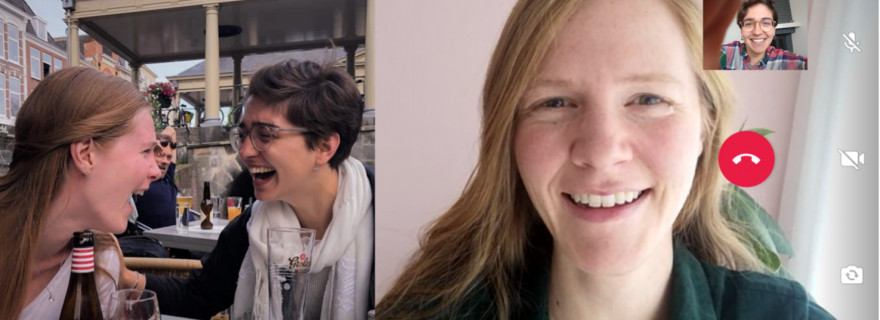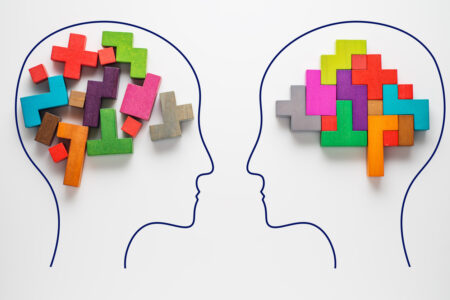Can video calls with friends replace real social encounters?
Meeting a friend in Covid-19 times has little to do with an intimate chat in a bar. Instead, video calls have become the new medium to share our innermost feelings. But can these moments of online face-to-face communication replace the ‘real’ offline experience?
“Oh wait – can you hear me? – It’s a bit noisy… But can you see me?” At the moment, this is how pretty much every conversation with a friend starts. The Covid-19 pandemic has landed us in an era of communication in which the “new” normal is to meet via video chat apps. But even on the rare occasions without technical connection problems, can we actually “connect” to another person?
Lacking connections
I find it difficult to grasp how the person on the screen really feels. And this applies not only to me, as someone who even studies the communication of emotions. People all around the world miss the good old days when you could simply catch up with a friend in a bar. We lack real connections with others and, as a result, increasingly suffer from loneliness. Is this only because we’re not yet used to the new “normal”? Or is a connection via video just harder to build?
The “video” face
When chatting via webcams, we can see our friends’ faces on the screen but can’t look them directly in the eye. And that sense that something’s missing is not just a feeling. In fact, sharing gaze has been shown to initiate the “eye contact effect”, which boosts a quick understanding and liking of the other. Lacking this component in video calls takes away the natural smoothness of a face-to-face conversation.
And it’s not just our eyes – the rest of the face also suffers drawbacks when it comes to communication via video. While a smile can be spotted in different light conditions, camera resolutions or frame rates, this is impossible for more subtle changes in the face. Being of short duration and/or low intensity, these largely uncontrollable changes are, however, the key to someone’s real emotional state. If your friend wants to be secretive, you may never learn about their true feelings.
What about the body talk?
Sitting opposite a friend at a bar, we get to see not only each other’s faces but also our entire bodies. These bodies, like our faces, are a reflection of our inner states. Remember that time when you wanted to shrink away to nothing and you just couldn’t drag your feet off the ground? Based on your body posture and movement, most people would have guessed you felt miserable. And, especially in the case of strong emotions such as triumph, the body can tell a lot more than the face. When we’re sitting hunched up in front of a screen, in contrast, body language can only play a negligible role in the conversation.
Another way we use our body to build connections to others is via touch. Getting a big hug is not only a pleasurable experience – it can also strengthen the bond between people and help them deal with their sorrows. Moving closer to a crying friend is an instinctive reaction. Comforting her via video, on the other hand, can be quite difficult and frustrating.
Being in two places
An exchange with your friend, however, does not only depend on your faces and bodies. Your environment shapes how you experience things – thus, not being in the same space, quite literally, can hinder the meeting of minds. When I skyped with a friend living in Qatar a few weeks ago, pretty much everything in our environment differed: not only the temperature and the surroundings, but also local culture and attitudes. As a consequence, his frustration about the ‘new’ normal was not very relatable to me. In contrast, being in the same environment, e.g. watching a movie in the same room, has been shown to result in an alignment of emotional states. Even if people do not directly communicate about their environment, sharing the same context can make experiences more similar.
On top of all this, in real life we actively engage with each other and with our environment. In a bar situation, this could mean for example that you and your friend might hand the menu back to the cute waiter and, knowing what the other is thinking, exchange a conspiratorial glance. Clearly, you are on the same wavelength at that moment. And this is not just a saying – shared engagement also yields a stronger alignment in brain activity! Consequently, ‘syncing’ with another person in real life can be expected to go above and beyond aligning your thoughts in a video communication.
The perks of video calls: staying in touch
If I know a person well enough, I have less difficulty ‘seeing’ what’s going on in their head. For example, listening to an old friend’s story about a walk in the forest next to our primary school, I can vividly depict the scenery. Plus, I can feel how much she, as a nature-lover, must have enjoyed it! By sharing experiences and exchanging thoughts in the past, close friends have already been on the same wavelength a million times. This not only leaves them with similar values and views about the world, but also results in similar brain responses to the environment and even allows them to tune in to one another more easily. Although video telephony does not provide us with the richness of real-life information, the pieces we get should still be enough to solve the puzzle of our friend’s mind.
And, actually, these pieces are not too bad – there is still a lot of nonverbal communication one can pick up on in a video call! We can let our faces speak in terms of smiles, frowns and the like. We can even detect seemingly invisible signals like the heartbeat in another person’s videotaped face. This information is specifically valuable as it tells us something about unfiltered emotional states. Integrating what we see, hear from and know about our friends can thus be the key to staying informed about how they are doing.
Keeping in touch nowadays is not even a matter of where your friends are. Spatial and temporal limitations of in-person encounters are alien to video calls, which can connect people whenever and wherever. Travel bans in the last few months led me to move back and forth between my home town in Germany and the Netherlands. Thanks to today’s technical possibilities, I have never had to miss seeing a loved one’s face, either in my old or my new home. And even contacts with old friends living on different continents have started to flourish again – just because video calls have become the ‘common’ way to meet up!
Embrace the challenge
To sum up, video calls and personal encounters do differ in the richness of the social experience. We are lacking detailed information from the face and can’t really connect via our bodies. Moreover, being in different environments can complicate our attempts to end up on the same wavelength. Nevertheless, especially when talking to emotionally close but spatially distant friends, video calls are an effective tool for sharing our ups and downs. So, can video calls with friends replace real social encounters? No, they definitely cannot. But they can help us stay connected.
To put things in a different perspective, the limits of video calls could even be seen as a chance for a more explicit way of communication. For example, instead of hoping a friend might pick up on signs indicating how I really feel about my ex’s new relationship, I could also simply say “It hurts” – and there’s no way my friend won’t get that!





